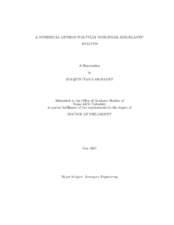| dc.description.abstract | This work presents a numerical method for the analysis of fully nonlinear aeroelastic
problems. The aeroelastic model consisted of a Navier-Stokes flow solver, a nonlinear
structural model, and a solution methodology that assured synchronous interaction
between the nonlinear structure and the fluid flow.
The flow around the deforming wing was modeled as unsteady, compressible and
viscous using the Reynolds-averaged Navier-Stokes (RANS) equations. To reduce the
computational time, a three-level multigrid algorithm was implemented and the flow
solver was parallelized. The message-passing interface (MPI) standard libraries were
used for the parallel interprocessor communication.
The computational domain was divided into topologically identical layers that
spanned from the root to past the tip of the wing. A novel mesh deformation algorithm
was developed to deform the mesh as the structure of the wing was being displaced.
The mesh deformation algorithm was able to handle wing tip deformations of up to
60 % of the wing semi-span. Besides being robust, the mesh deforming algorithm was
computationally more efficient than regriding, since deforming an existing mesh was
computationally less expensive than generating a new mesh for each wing position.
Results are presented for the validation and verification of both the flow solver
and the aeroelastic solver. The flow solver was validated using: (1) the flow over
a flat plate, to validate the turbulent model implementation, and (2) the flow over
the NACA 0012 airfoil and over the F-5 wing, to validate the implementation of the convective and viscous fluxes, the time integration algorithm, and the boundary
conditions. The aeroelastic solver was validated using: (1) the unsteady F-5 wing
undergoing forced pitch motion, and (2) the Nonlinear Aeroelastic Test Apparatus
(NATA) wing. In addition, aeroelastic results were generated for the Goland wing.
The aeroelastic solver developed herein allows the analysis of aeroelastic phenomena
using a fully nonlinear approach. Limit cycle oscillations, which are highly
nonlinear phenomena, were captured by the nonlinearities of the flow solver and the
structural solver. The impact of the nonlinearities was assessed for the Goland wing,
where nonlinear terms changed dramatically the aeroelastic behavior of the wing. | en |


